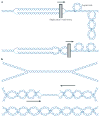DNA topoisomerase II and its growing repertoire of biological functions
- PMID: 19377505
- PMCID: PMC2730144
- DOI: 10.1038/nrc2608
DNA topoisomerase II and its growing repertoire of biological functions
Abstract
DNA topoisomerases are enzymes that disentangle the topological problems that arise in double-stranded DNA. Many of these can be solved by the generation of either single or double strand breaks. However, where there is a clear requirement to alter DNA topology by introducing transient double strand breaks, only DNA topoisomerase II (TOP2) can carry out this reaction. Extensive biochemical and structural studies have provided detailed models of how TOP2 alters DNA structure, and recent molecular studies have greatly expanded knowledge of the biological contexts in which TOP2 functions, such as DNA replication, transcription and chromosome segregation -- processes that are essential for preventing tumorigenesis.
Figures



References
-
- Champoux JJ. DNA topoisomerases: structure, function, and mechanism. Annu Rev Biochem. 2001;70:369–413. - PubMed
-
- Wang JC. Moving one DNA double helix through another by a type II DNA topoisomerase: the story of a simple molecular machine. Q Rev Biophys. 1998;31:107–44. - PubMed
-
- Sundin O, Varshavsky A. Arrest of segregation leads to accumulation of highly intertwined catenated dimers: dissection of the final stages of SV40 DNA replication. Cell. 1981;25:659–69. - PubMed
-
- Sundin O, Varshavsky A. Terminal stages of SV40 DNA replication proceed via multiply intertwined catenated dimers. Cell. 1980;21:103–14. - PubMed
-
- Bates AD, Maxwell A. DNA topology. Oxford University Press; Oxford: 2005.
Publication types
MeSH terms
Substances
Grants and funding
LinkOut - more resources
Full Text Sources
Other Literature Sources
Miscellaneous

